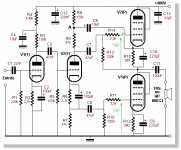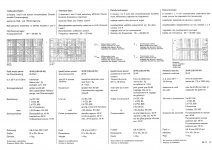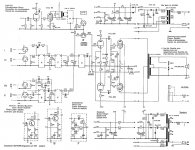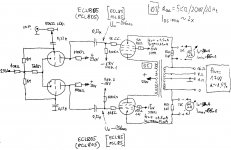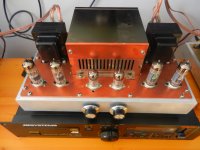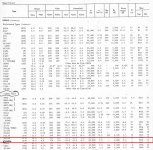@Merlinb
Also true! In many cases a question does not show the reason behind it so some guesswork is needed. Many threads start with a question like this and even though everyone is trying to help out with good intentions missing the point of the requester and the thread becomes a discussion of a totally different topic (nitpicking about the exact tube type even though the point made was clear makes a thread difficult to follow).
So, the question what is better i answered clearly, use what you have at hand or easy to get your hands on and how i would use these tubes if i had to make this choice looking at the specs. Arguably a 100 different tubes can be used successfully if you are willing to invest in them. The forum is full of ideas but if the answer was to be found here this thread would not exist.
Best regards, Frank
Also true! In many cases a question does not show the reason behind it so some guesswork is needed. Many threads start with a question like this and even though everyone is trying to help out with good intentions missing the point of the requester and the thread becomes a discussion of a totally different topic (nitpicking about the exact tube type even though the point made was clear makes a thread difficult to follow).
So, the question what is better i answered clearly, use what you have at hand or easy to get your hands on and how i would use these tubes if i had to make this choice looking at the specs. Arguably a 100 different tubes can be used successfully if you are willing to invest in them. The forum is full of ideas but if the answer was to be found here this thread would not exist.
Best regards, Frank
Last edited:
The ECL85/805 and ECL82 are almost the same tube actually.
Very little difference in terms of transconductance, internal resistance etc
I would be interested in the thoughts behind the production of these tubes.
The information and application description says more just about the marketing than anything else (similar like datasheets these days).
It feels a lot like they just cherry picked ECL82's for audio.
Even if you look at the bulbs themselves they basically look identical.
Also because the ECL85 datasheets just vary so much.
But that is just speculation from my side.
Depending on your expectation, but you can build a very nice audio amplifier with these tubes.
Especially with the ECL805 or PCL805 which even have an higher power dissipation.
(or rather specified at least).
A little bit of negative feedback will also help in any case.
In single ended mode you can expect 0.45% * Wa = about 3.5-5W
For push-pull roughly 2*Wa*0.7% = 11-15W
Very little difference in terms of transconductance, internal resistance etc
I would be interested in the thoughts behind the production of these tubes.
The information and application description says more just about the marketing than anything else (similar like datasheets these days).
It feels a lot like they just cherry picked ECL82's for audio.
Even if you look at the bulbs themselves they basically look identical.
Also because the ECL85 datasheets just vary so much.
But that is just speculation from my side.
Depending on your expectation, but you can build a very nice audio amplifier with these tubes.
Especially with the ECL805 or PCL805 which even have an higher power dissipation.
(or rather specified at least).
A little bit of negative feedback will also help in any case.
In single ended mode you can expect 0.45% * Wa = about 3.5-5W
For push-pull roughly 2*Wa*0.7% = 11-15W
I think you can never blame an unknowing person for asking the "wrong" question, since he is totally unaware of it.Also true! In many cases a question does not show the reason behind it so some guesswork is needed. Many threads start with a question like this and even though everyone is trying to help out with good intentions missing the point of the requester and the thread becomes a discussion of a totally different topic (nitpicking about the exact tube type even though the point made was clear makes a thread difficult to follow).
So, the question what is better i answered clearly, use what you have at hand or easy to get your hands on and how i would use these tubes if i had to make this choice looking at the specs. Arguably a 100 different tubes can be used successfully if you are willing to invest in them. The forum is full of ideas but if the answer was to be found here this thread would not exist.
Best regards, Frank
But what happens very often in these kind of topics or comments, is that people have a tendency to completely drop their personal taste on things, without explaining context.
It just all depends on expectations and context.
I would be interested in the thoughts behind the production of these tubes.
The information and application description says more just about the marketing than anything else (similar like datasheets these days).
I only can tell from the historical situation in Germany: When TV sets came up in the 1950ies, they first had very few different tube types in them, but some of them in big numbers. So some tubes were used universally. The ECL80, for instance, was seen at four different places in one and the same TV set: Audio amplifer, sync separation, sweep oscillator and frame deflection oszillator/amplifier. When the deflection angle changed from 70° to 90°, the ECL80 wasn't powerful enough. So the PCL82 followed as the frame oscillator and amplifier, but as the audio amplifier as well, as it could provide double the AF power. This tube also served well in early 110° TVs.
At some point the manufacturers' economists started to think about decreasing production costs. Decreasing the size of the frame deflection transformer was one point. This needed to be done by raising the primary AC current, which called for a more powerful tube. Consequently, the PCL85 was born and dropped into that service. There seemed to be a need to increase AF output as well, which lead to the PCL86.
Note that the introduction of the PCL85 may have saved some production costs, but at the expense of power consumption! Anyway, no one cared about this in the early 1960ies.
Best regards!
Btw, some may note that I didn't mention the PCL81. Yes, this is true. But I never saw a TV set with this tube, so I can't tell what it was used for.
Last edited:
I think you can never blame an unknowing person for asking the "wrong" question, since he is totally unaware of it.
But what happens very often in these kind of topics or comments, is that people have a tendency to completely drop their personal taste on things, without explaining context.
It just all depends on expectations and context.
Well, my expectations were not very high. I am just curious about experiences of other members with the ECL85 compared to the ECL86 in the context of building a simple amp. Until now only Tom Schlangen seems to have this experience. He clearly prefers the ECL85. It is subjective information of course but I find this very worthful. Other information based on datasheets can also be interesting and certainly helps. But a suggestion to use a ECL82 is not really an answer I am waiting for.
There is some other reason behind my question: these days it is difficult to obtain good ECL86s and I have also a Lafayette amp that already takes 4 of them. And I have a bunch of good ECL85/805 lying here doing nothing...
Very interesting stories indeed!I only can tell from the historical situation in Germany: When TV sets came up in the 1950ies, they first had very few different tube types in them, but some of them in big numbers. So some tubes were used universally. The ECL80, for instance, was seen at four different places in one and the same TV set: Audio amplifer, sync separation, sweep oscillator and frame deflection oszillator/amplifier. When the deflection angle changed from 70° to 90°, the ECL80 wasn't powerful enough. So the PCL82 followed as the frame oscillator and amplifier, but as the audio amplifier as well, as it could provide double the AF power. This tube also served well in early 110° TVs.
At some point the manufacturers' economists started to think about decreasing production costs. Decreasing the size of the frame deflection transformer was one point. This needed to be done by raising the primary AC current, which called for a more powerful tube. Consequently, the PCL85 was born and dropped into that service. There seemed to be a need to increase AF output as well, which lead to the PCL86.
Note that the introduction of the PCL85 may have saved some production costs, but at the expense of power consumption! Anyway, no one cared about this in the early 1960ies.
Best regards!
Btw, some may note that I didn't mention the PCL81. Yes, this is true. But I never saw a TV set with this tube, so I can't tell what it was used for.
Thanks!
ECL80 is a very nice cute little tube! (as well as the ECL/PCL81!)
Although, this is still seen from a consumer point of view.
Production can be as simple as cherry picking (especially back in the day), speccing things that weren't spec't before, slapping on just some extra fins to increase certain specs or sometimes just nothing more than some paper work etc etc etc
If people have been into production and marketing, they know exactly what I am talking about.
I have seen similar stories with speakers; same speaker, different market, slightly different color just to make the cosmetic difference and price x 4.
But under the hood 100% the same product. Just bias certain cherry picked specs when needed (and named differently in the other product)
If specs fall into the same ballpark and construction is more or less the same, to me that is just the same tube. Especially seen the tolerances back in the day.
Anyway, I am still very surprised that these kind of stories can't be found anywhere from so ex-veteran-engineers back in the day (or people who know how it was done at least)
But going off-topc here I guess, sorry, still interesting subject. 🙂
I would just go for the PCL versions, and lift the heater with either a good old voltage multiplier, or just a boost converter, or just use a seperate transformer/PSUWell, my expectations were not very high. I am just curious about experiences of other members with the ECL85 compared to the ECL86 in the context of building a simple amp. Until now only Tom Schlangen seems to have this experience. He clearly prefers the ECL85. It is subjective information of course but I find this very worthful. Other information based on datasheets can also be interesting and certainly helps. But a suggestion to use a ECL82 is not really an answer I am waiting for.
There is some other reason behind my question: these days it is difficult to obtain good ECL86s and I have also a Lafayette amp that already takes 4 of them. And I have a bunch of good ECL85/805 lying here doing nothing...
What I normally do, is just compare specs between tubes.
If they are basically the same, or the same ball park, you can expect similar performance.
Last edited:
Many Opinions
But few proofs to back up those opinions. The project on a 6F5P mentioned earlier is very well covered, something that can be depended on.🙂
But few proofs to back up those opinions. The project on a 6F5P mentioned earlier is very well covered, something that can be depended on.🙂
PP or SE or both?
Philips circa 1960.🙂 Its PP.
GenRad tried it too. See General Radio Experimenter Oct 1951.
Attachments
P type valves make great candidates for DIY, have used PL84's (EL86's with different heaters) to great effect and can still pick up a quad of Telefunken's for less than the price of one EL86.
Shoog
Shoog
SEPP is both btw. I just wanted to know what kind of amp is going to be build in the first place or has this yet to be determined?
So then Let’s not offer any PP schematics....
I rest my case ....,
Best regards, Frank
I rest my case ....,
Best regards, Frank
Last edited:
Futher background: This should be a small but good sounding amp to drive high efficiency open baffle speakers and headphones. Kind of a reference to compare with larger SE designs that are yet to come.
And I have ideas to use this amp as a driver stage for a larger triode (e.g. KT88 and larger). Kind of modulair concept.
And I have ideas to use this amp as a driver stage for a larger triode (e.g. KT88 and larger). Kind of modulair concept.
Just calculated in my spreadsheet.These OT impedances are not that different as with ECL86. My OPT's are probably 7k so I think it is worth trying it. I run them on 300V/30mA...
For an ECL85 @ 7k you would probably want a Va-c (anode-cathode) of around 250V running around 32mA for perfect center bias.
This will give around 3.8W output power.
Grid bias voltage will be around 29.5V, so you need around 280V B+
Last edited:
P type valves make great candidates for DIY, have used PL84's (EL86's with different heaters) to great effect and can still pick up a quad of Telefunken's for less than the price of one EL86.
Shoog
At first read I thought you were comparing to N type valves. Would sure make design easier!😱
In the distant past I did several with PP 25L6 & PP 35L6.🙂
- Home
- Amplifiers
- Tubes / Valves
- ECL86 or ECL85 for mini amp?
